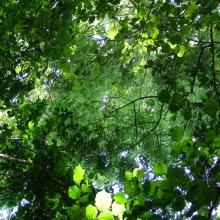Professional summary
Emma previously worked as an astrophysicist, building models that simulate the accretion flows and relativistic jets around black holes. She specialised in studying variability in these complex, interacting systems. Now she uses the same techniques to investigate how ecological systems vary over space and time.
Emma leads the development of the *4pop models. These are computer models that simulate how species use landscapes. She works with researchers, NGOs and conservation volunteers to translate the latest understanding of species' needs into models that predict where species are living, which parts of landscapes are important to them and how they might be affected by landscape changes.
These process-based models simulate the foraging, dispersal and population processes of species with different ecologies. So far, they have been developed for bees, birds, bats, reptiles, amphibians, moths and plants. They have been used by decision-makers across the UK to assess the potential consequences of proposed habitat loss, to quantify the effects of previous habitat creation, inform further habitat creation, and target on-the-ground survey efforts.
Emma also explores how non-human species' needs are represented in human decision-making and how this could be improved. She works with decision-makers to investigate this across a range of spatial scales, from national and local government to grass-roots community action. She also collaborates with researchers across the arts, humanities and sciences to examine these issues from an interdisciplinary perspective.
To find out more about our work developing and applying *4pop models, visit: https://star4pop.wordpress.com/
Blaydes H., Gardner E., Whyatt J.D., Potts S.G., Dunford‐Brown R., Redhead J.W., and Armstrong A., (2025) Solar farms as potential future refuges for bumblebees. Global Change Biology, 31(10), 70537 https://doi.org/10.1111/gcb.70537
Knight, E., Balzter, H., Breeze, T.D., Brettschneider, J., Girling, R.D., Hagen‐Zanker, A., Image, M., Johnson, C.G., Lee, C., Lovett, A. and Petrovskii, S., (2024). Adapting genetic algorithms for multifunctional landscape decisions: A theoretical case study on wild bees and farmers in the UK. Methods in ecology and evolution, 15(11), pp.2153-2167 https://doi.org/10.1111/2041-210X.14424
Gardner E., Robinson R.A., Julian A., Boughey K., et al. (2024) A family of process-based models to simulate landscape use by multiple taxa. Landscape Ecology, 39(5), 102 https://doi.org/10.1007/s10980-024-01866-4
Cole B., Bradley A.V., Willcock S., Gardner E., Allinson E., Hagen‐Zanker A., Calo A.J., Touza J., Petrovskii S., Yu J. and Whelan M. (2023) Using a multi‐lens framework for landscape decisions. People and Nature, 5(4), 1050 https://doi.org/10.1002/pan3.10474
Image M., Gardner E., and Breeze T.D. (2023) Co-benefits from tree planting in a typical English agricultural landscape: Comparing the relative effectiveness of hedgerows, agroforestry and woodland creation for improving crop pollination services. Land Use Policy, 125, 106497 https://doi.org/10.1002/pan3.10474
Image M., Gardner E., et al. (2022) Does agri-environment scheme participation in England increase pollinator populations and crop pollination services? Agriculture, Ecosystems & Environment, 325, 107755 https://doi.org/10.1016/j.agee.2021.107755
Gardner E., Sheppard A., and Bullock J.M. (2022) Why biodiversity net gain requires an ecological permission system. Town and Country Planning https://eprints.glos.ac.uk/11918/
Gardner E., Breeze T., et al. (2021) Field boundary features can stabilise bee populations and the pollination of mass-flowering crops in rotational systems, Journal of Applied Ecology, 58, 2287 https://doi.org/10.1111/1365-2664.13948
Gardner E., Breeze T., et al. (2020) Reliably predicting pollinator abundance: Challenges of calibrating process-based ecological models, Methods in Ecology and Evolution, 11, 1673 https://doi.org/10.1111/2041-210X.13483
Gardner E., Julian A., Monk C., and Baker J. (2019) Make the Adder Count: population trends from a citizen science survey of UK adders. Herpetological Journal, 29, 57 https://doi.org/10.33256/hj29.1.5770
